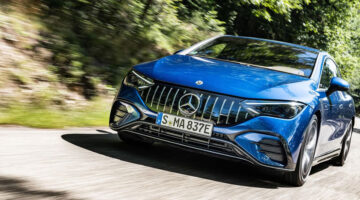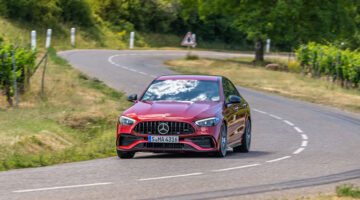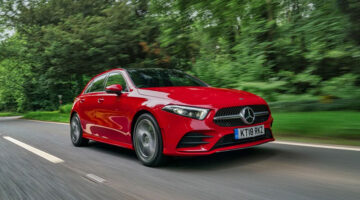Has Mercedes-Benz opened a new chapter in compact car history with the new A-Class? We discover it just might have…
| Engine | Power | Torque | 0-100kph | Top speed | Weight | Price |
|---|---|---|---|---|---|---|
| Inline 4cyl, turbo, 1991cc | 221bhp @ 5,500rpm | 258lb ft @ 1,800rpm | 6.2secs | 250kph (limited) | 1,455kg (152bhp/ton) | TBC |
| Shrink an S-Class into a hatchback, and you get the idea | |
| Performance may not suit everyone |
We’ll give you a moment; just take a look at that interior.
Breathtaking, isn’t it? Even for Mercedes, for whom ‘refined cabins’ have long since been the norm, the design of the fourth generation A-Class is particularly striking.
Let’s start with the dashboard, arguably the most distinctive feature of Mercedes’ new ‘Sensual Purity’ design language. The cowl above the driver’s instrument cluster has been removed entirely, as has, incidentally, the cluster itself, meaning the focal points are now the exquisite turbine-esque air vents and the free-standing display mounted to the dashboard that replaces conventional dials. Yes, those turbine vents are illuminated, and yes, the 7-inch screen that comprises the display can be upgraded to a 10.25-inch version for a handful of extra cash.
Mercifully, the display itself has been mounted much more elegantly than the ‘afterthought’ version that blighted the third generation model and the centre display is, naturally, touch sensitive. There are some sporty touches on our ‘AMG-Line’ test model of course, including the low-mounted, well-bolstered sport seats and the flat(ish) bottomed steering wheel that brings features such as controls to customise the instrument cluster display. First introduced to the S-Class, the wheel blends perfectly into the overall elegance of this cabin – it’s slick, it’s minimalist, and it’s beautiful.
It’s also stuffed to the proverbial gills with tech, driver assist systems like Active Lane Change Assist, adaptive cruise control and predictive rear-end collision detection having been plucked straight from the S-Class flagship. Of greater note though is the brand new MBUX Linguatronic, Mercedes-Benz User Experience (MBUX), a new multimedia interface that makes its debut, again, quite incredibly, on the company’s entry-level model. To experience the system’s true ‘Emotional Connection’ – if you will – it’s more fun to activate by saying; “Hey, Mercedes.” Once you’ve done that, MBUX regulates cabin temperature, operates multimedia, seat posture, how ajar you want the windows, and even your destination’s weather forecast. Though we didn’t test this, we wouldn’t be surprised if MBUX could tell you how much change you had in your pocket. The augmented-reality navigation which overlays images from the car’s front facing camera with direction arrows, street names and house numbers for ease of use in the city, adds to this overall immersive and intuitive user experience.
Cynics might be quick to decry this as superficial artifice, but bear in mind that there’s plenty of head- and elbowroom in the front, and cavernous boot space for a compact model. Admittedly though, the new A250 sits atop an extended wheelbase, but you’ll struggle to feel those additional 30mm in the rear, where head- and legroom is still at a premium. However, the newly sharpened exterior similarly does more than look good, as there are a lot of aerodynamic considerations at play.
The tweaked radiator and headlights make for a strong look but take a closer look at the wing mirrors, which are now mounted on the doorsills. These, like the more steeply raked bonnet and subtly angled 17-inch alloys on our test car, have been designed to reduce drag as much as possible. We’re told that the CdA is comparable to that of a mountain biker, and rumours abound that even the lettering on the tyres is specifically no higher than 0.2mm.
Incredible if true, and certainly conceivable given the quite extraordinary civility inside the cabin – crank that 2-litre turbo into the high revs and somehow wind- and road roar are still held at bay. It’s the ride, though, that truly blows me away, the dampers offering just enough suppleness to create a beautifully fluid ride comfort. It’s not overly hyperbolic to say that the A-Class legitimately rivals the C-Class in terms of refinement.
Of course one of the bigger questions is how does it drive? And here we get into slightly murky territory: not exactly the sharpest of cars to drive across its two-decade lifespan, it’s clear that comfort and refinement have taken priority over ‘performance’ in the fourth generation, too.
Now there are a few reasons why this might be the case. For starters, being ‘more fun’ to drive than the Volkswagen Golf GTI, the current king, was always going to set our A250 up to fail, and with the new AMG A45 inevitably round the corner, it’s unlikely the fastest A-Class available for now was going to venture too close to Affalterbach’s toes. Bear in mind also that prospective customers for the A250 include those aspiring to own a Benz for the first time, and those looking to downsize from the C-Class without sacrificing civility or refinement. Neither exactly screams lift-off oversteer or heel-and-toe, does it?
Having said that, the A250 nevertheless does an admirable, if not exactly eye-popping job when grabbed by the throat and hustled. The 2-litre, four-cylinder for instance – effectively unchanged but upgraded to run more efficiently – produces a stout 221bhp and 258lb ft. of twist, all sent through the front wheels (4MATIC four-wheel drive is expected to appear at a later date). Initial pick-up feels suitably torquey and responsive, there’s no real audible strain in the high revs and speed is built with commendable linearity. Even the 7G DCT transmission feels smooth and attentive, particularly when coupled with sharp throttle response. Lively then, yes, but not particularly eager, and certainly lacking the electricity some fans may have expected of the three-pointed star. Zero-to-100kph is completed in 6.2 seconds but the A250 is still outgunned by the lower powered VW across the same distance.
Then there’s the handling, which feels sharp and direct. The limit of grip can be found quickly if you get too carried away and the steering, though accurate, lacks the textured feedback we hoped Mercedes would have nailed down after two decades. Saying that, body control is reasonably maintained, thanks in part to the adaptive dampers and multi-link suspension that come as standard on the A250 (the lower tier A200 gets a conventional torsion beam).
I’m tempted to knock a point or half off my final score based on this sporty (albeit slightly underwhelming) performance but, truth be told, that would be doing the A250 a huge disservice. Get your angry letters at the ready, because I absolutely LOVE this car.
Yes, fine, it’s fast but could be faster, handles nicely but could be more direct, and feels sporty but could be more energetic. But try, really try to look past that, and you’ll find a hatchback that legitimately offers the civility, refined acoustics and technological sophistication of saloons way above it on Mercedes’ product line-up, and for considerably less money. The cabin design is close to flawless, the driver-assistance tech is nicely augmented, and when you bring the revs back down below ‘the limit’, you begin to realise just how accomplished, luxurious and capable the A-Class truly is.
Take issue with this all you like, but for me the fourth generation A250 is a stunning new chapter in compact motoring history, Mercedes-Benz or otherwise.



